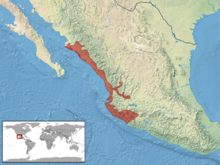Crotalus basiliscus
| Crotalus basiliscus | |
|---|---|
 |
|
| Scientific classification | |
| Kingdom: | Animalia |
| Phylum: | Chordata |
| Class: | Reptilia |
| Order: | Squamata |
| Suborder: | Serpentes |
| Family: | Viperidae |
| Genus: | Crotalus |
| Species: | C. basiliscus |
| Binomial name | |
|
Crotalus basiliscus (Cope, 1864) |
|
 |
|
| Synonyms | |
Crotalus basiliscus is a venomous pit viper species found in western Mexico. The specific name is derived from the Greek word for king, basiliskos, and alludes to this snake's large size and potent venom. No subspecies is currently recognized.
This is one of the largest rattlesnake species. Specimens exceeding 150 cm (4.9 ft) are not uncommon, while the maximum size reported is 204.5 cm (6.71 ft) (Klauber, 1972). The body is moderately stout and rather rectangular in cross section.
At midbody, 25-29 rows of strongly keeled dorsal scales occur. The ventral scales number 174-206 and the subcaudals 18-36.
The color pattern consists of brown or grayish ground color overlaid with 26-41 dark, rhombus-shaped (diamond) blotches with light edges. The head is a uniform grayish-brown except for its lighter labial scales and dark postorbital bar. No distinct pattern is found on the crown or neck areas. The tail may be gray, with darker bands, or almost uniform in color without any distinct markings. The belly is white or cream-colored. The young are mostly red, but adults eventually become an olive green. Within its range, this is the only rattlesnake with diamond-shaped dorsal markings.
This snake often occurs in the same areas as C. molossus, where the two appear to hybridize freely. While these two species are easily distinguished, identifying the hybrid specimens is problematic.
Mexican west coast rattlesnake, Mexican green rattler, Mexican west coast green rattlesnake.
This rattler is found in western Mexico from southern Sonora to Michoacán, where it is mostly restricted to the coastal plain. The type locality given is "Near Colima, Mexico".
Around Colima, where it is (or was at one point) particularly plentiful, the area has been described as mostly treeless and covered with short grass with scattered clumps of mesquite, acacias, and other thorny bushes, as well as plenty of large cacti. The habitat of C. basiliscus is mostly tropical thorn forest, with an extension into tropical deciduous forest.
...
Wikipedia

